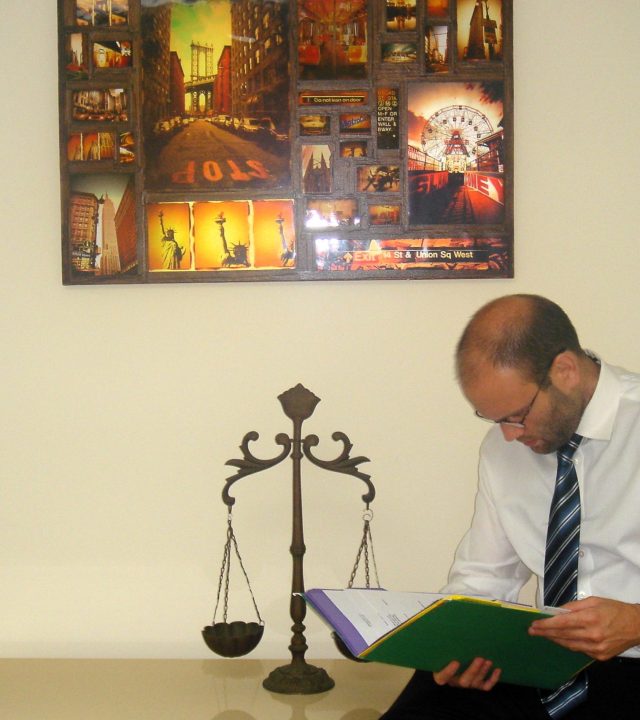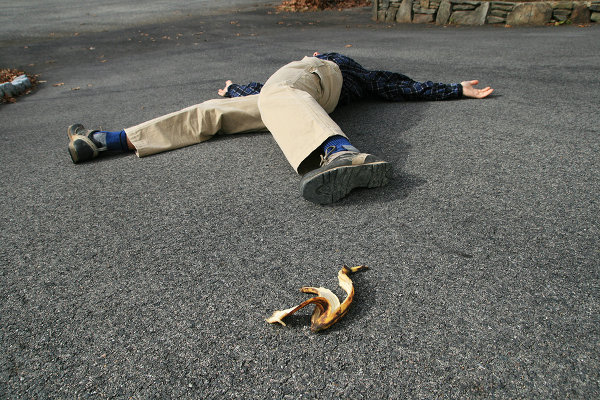How Our Bronx Personal Injury Lawyers Can Help After a Slip and Fall
Slip and Fall Accident Lawyer Bronx


Have you fallen and hurt yourself on someone else’s property? The pain, medical bills, and time away from work can be overwhelming. At the Law Office of Daniel Levy, LLP, our Slip/Trip and Fall Accident Lawyer Bronx team is ready to help you through this difficult time.
When you suffer a fall because of dangerous conditions that should have been fixed, you deserve compensation. Our experienced lawyers know exactly how to handle these cases. We will:
Our Bronx fall injury lawyers have helped countless people just like you. We know the tactics property owners and insurance companies use to avoid responsibility. More importantly, we know how to counter these tactics to protect your rights.
You focus on healing. We’ll focus on getting you justice.
Officia officiis vitae hendrerit interdum pretium.
Officia officiis vitae hendrerit interdum pretium.

Slip and fall accidents aren’t just bad luck. They happen because someone didn’t take proper care of their property. New York law requires property owners to keep their premises safe for visitors. This legal concept is called “premises liability.”
Property owners and managers have specific responsibilities:
When property owners neglect these duties, people get hurt. Our Slip/Trip and Fall Accident Lawyer Bronx professionals understand how to prove a property owner knew (or should have known) about a dangerous condition and failed to address it.
If you’ve been injured because someone didn’t meet their legal responsibilities, you have the right to seek compensation for your injuries and losses.
The Bronx presents unique challenges that can lead to dangerous falls. Our trip and fall attorney Bronx team has handled cases involving many different hazards:
Our premises liability lawyer NY experts know how to identify exactly what caused your fall. We work with safety experts and investigators to document dangerous conditions before they can be repaired or hidden by property owners.
Slip and fall accidents can happen anywhere in the Bronx, but our Slip/Trip and Fall Accident Lawyer Bronx team sees certain locations more frequently:
No matter where your accident happened, our Bronx fall injury lawyers can determine who is responsible. Sometimes multiple parties share liability – property owners, management companies, maintenance contractors, or even government entities might be legally responsible for your injuries.
If your fall resulted from a Bronx truck accident lawyers or involved a commercial vehicle, we can help with that too. We have extensive experience handling all types of personal injury cases in the Bronx.
Falling accidents often lead to serious injuries that can affect your life for weeks, months, or even permanently. Our Slip/Trip and Fall Accident Lawyer Bronx team has helped clients recover compensation for many types of injuries:
Even injuries that seem minor at first can develop into serious medical conditions. Always seek medical attention after a fall, even if you think you’re “just sore.”
Our trip and fall attorney Bronx professionals work closely with medical experts to understand the full extent of your injuries and how they will affect your life going forward. This thorough approach ensures we seek compensation for all your current and future medical needs.
If your injuries are particularly severe, similar to those in pedestrian accidents, we have the expertise to handle complex, high-value claims.
When you work with our Slip/Trip and Fall Accident Lawyer Bronx team, we’ll fight for every dollar you deserve. Compensation (also called “damages”) in slip and fall cases typically falls into these categories:
In cases involving extreme negligence or properties with known, uncorrected hazards, our premises liability lawyer NY experts may even pursue punitive damages designed to punish particularly bad behavior.
Our firm has recovered millions of dollars for slip and fall victims throughout the Bronx. While every case is different, we can evaluate your situation and give you a realistic assessment of what your case might be worth.
If your loved one died from injuries sustained in a fall, we can help you pursue a wrongful death claim to secure justice and financial support for your family.
Be prepared: after a slip and fall accident, property owners and their insurance companies rarely accept responsibility right away. Instead, they often try to blame you for what happened. Our Slip/Trip and Fall Accident Lawyer Bronx team has heard all these arguments before:
New York follows a “comparative negligence” rule. This means that even if you were partly responsible for your fall, you can still recover compensation. However, your award may be reduced by your percentage of fault.
For example, if your case is worth $100,000 but you’re found 20% responsible, you would receive $80,000.
Our Bronx fall injury lawyers know how to counter these blame tactics. We’ll gather evidence to show the property owner’s negligence was the primary cause of your accident. We’ll protect your right to fair compensation and fight any unfair attempts to shift blame to you.
Just like we do in rear-end accident cases, we’ll work diligently to establish the other party’s liability and minimize any arguments about your role in the incident.


After a slip and fall accident in the Bronx, you don’t have forever to take legal action. New York has strict deadlines called “statutes of limitations” for filing personal injury lawsuits:
Missing these deadlines can permanently bar you from recovering compensation, no matter how serious your injuries or how clear the property owner’s fault.
Other reasons to contact our Slip/Trip and Fall Accident Lawyer Bronx team quickly include:
Don’t delay in seeking legal help. Even if you’re unsure about pursuing a claim, a free consultation with our trip and fall attorney Bronx experts can help you understand your options and protect your rights.
Have you been injured in a slip, trip, or fall accident in the Bronx? The Law Office of Daniel Levy, LLP is here to help. Our experienced Slip/Trip and Fall Accident Lawyer Bronx team has the knowledge, skills, and dedication to fight for the compensation you deserve.
We understand how a sudden fall can turn your life upside down. Medical bills pile up while you’re unable to work. Pain and discomfort can make even simple daily activities challenging. Insurance companies pressure you to accept lowball settlements that don’t come close to covering your losses.
You deserve better. You deserve a legal team that will stand by your side, handle every aspect of your case, and fight tirelessly for your rights.
When you choose the Law Office of Daniel Levy, LLP, you get:
Don’t face this difficult time alone. Let our premises liability lawyer NY team shoulder the legal burden while you focus on healing.
Take the first step toward justice and recovery. Call us today at (929) 600-6422 to schedule your free consultation. Our friendly staff is standing by to help you start rebuilding your life after a slip and fall accident.
Remember, time limits apply to filing your claim. Don’t wait until it’s too late to seek the compensation you deserve. Contact the Law Office of Daniel Levy, LLP now.
Your recovery is our priority. Your justice is our mission.
Slip and trip accidents can have serious financial and physical consequences. Victims may face significant medical expenses, lost income due to time off work, and other damages. At the Law Office of Daniel Levy, LLP, we fight to recover full compensation for:
Covers hospital bills, doctor visits, physical therapy, and other healthcare needs.
Reimburses any income lost due to the accident, as well as any impact on future earning capacity.
Compensates for physical pain and emotional trauma related to the injury.
If the injury leads to long-term or permanent disability, we seek additional compensation for reduced quality of life and ongoing care.
Our team recently represented a Bronx resident who suffered a serious hip injury after slipping on a wet floor in a grocery store. The store failed to clean up a spill and had no warning signs. Through rigorous negotiation and evidence presentation, we secured a six-figure settlement to cover the client’s medical bills, lost wages, and pain and suffering. This is just one example of our dedication to getting results for our clients.
In New York, the statute of limitations for filing a personal injury claim, such as a slip or trip accident, is three years from the date of the accident. However, this timeframe may vary depending on the nature of the case and the parties involved:
What Happens If You Miss the Deadline?
Failing to file your claim within the statute of limitations will likely result in the court dismissing your case, and you will lose the opportunity to recover compensation.
How We Help:
At the Law Office of Daniel Levy, LLP, we ensure your claim is filed promptly and within the legal timeframe, safeguarding your rights.
Yes, you can still recover compensation even if you were partially at fault for your slip or trip accident. New York follows the comparative negligence rule, which means that your compensation will be reduced by the percentage of fault assigned to you.
How We Prove Your Case:
Our attorneys work to minimize your percentage of fault by presenting strong evidence that the property owner’s negligence was the primary cause of the accident. We do this by:
Building a strong slip or trip accident case requires substantial evidence to demonstrate the property owner’s negligence and connect it to your injuries. Here’s what we prioritize:
Visual evidence is one of the most compelling forms of proof in a premises liability case.
Medical documentation connects your injuries directly to the accident and helps quantify the financial and physical impact.
If the accident occurred on commercial property, report the incident to the manager or property owner immediately and request a written incident report. This report often becomes critical evidence in your case.
Eyewitnesses can corroborate your account of the accident and provide additional details about the hazardous condition. Ensure you collect their contact information at the scene.
Many commercial properties and apartment buildings have security cameras. This footage can provide undeniable proof of the hazard and the accident.
In some cases, experts like engineers, building inspectors, or safety specialists can testify about the property’s dangerous conditions and how they contributed to the accident.
How We Help:
At the Law Office of Daniel Levy, LLP, we thoroughly investigate your case and gather all necessary evidence to strengthen your claim.
The value of your slip or trip accident case depends on several factors, including the severity of your injuries, the financial losses you’ve suffered, and the overall impact on your quality of life. Here’s a breakdown of what determines the value of your claim:
These are quantifiable financial losses directly resulting from the accident.
These are less tangible losses that compensate for the emotional and physical toll of the accident.
In rare cases, punitive damages may be awarded if the property owner’s negligence was particularly egregious or reckless.
If your injuries result in long-term or permanent impairments, the compensation may include the costs of ongoing care, home modifications, and assistive devices.
Factors That Impact Your Case Value:
How We Maximize Your Compensation:
Our attorneys collaborate with medical professionals, economists, and vocational experts to calculate the full extent of your losses, ensuring you receive the maximum compensation possible.
We gather evidence such as photos, incident reports, and witness statements to show that the property owner’s negligence caused your injuries.